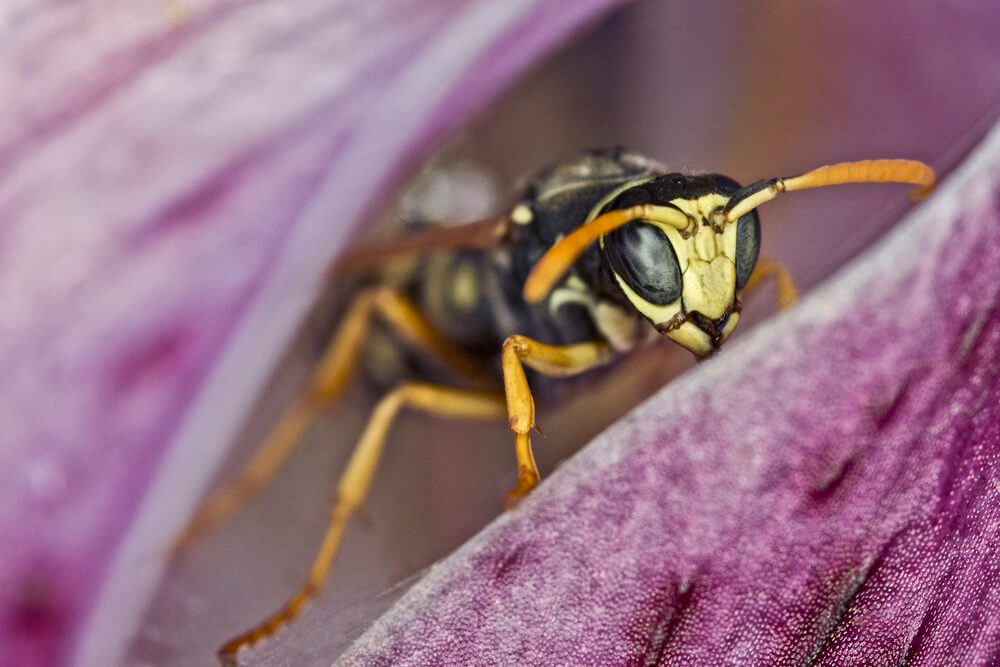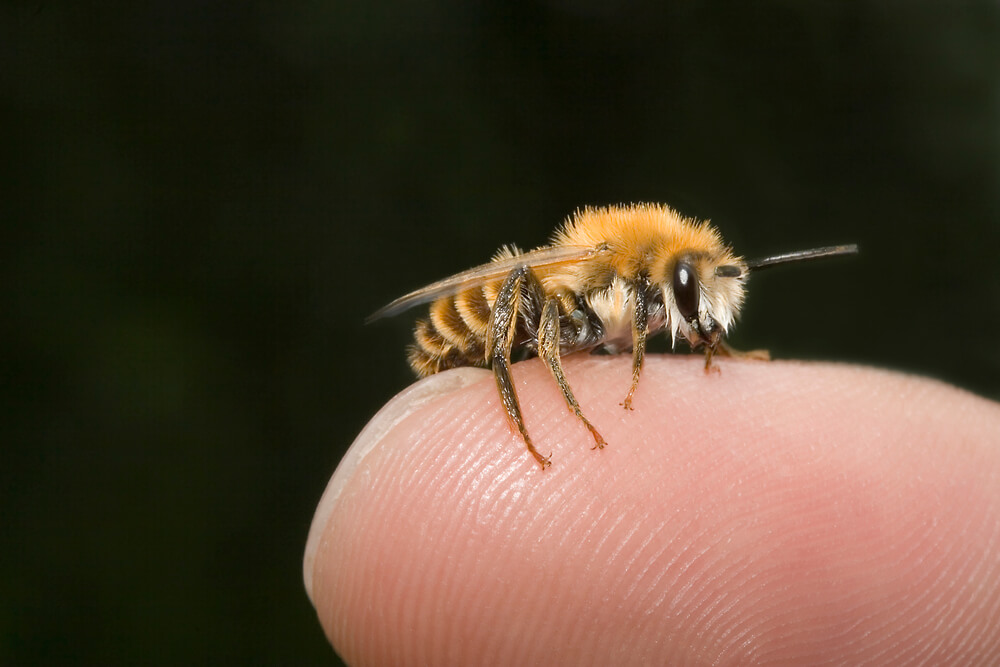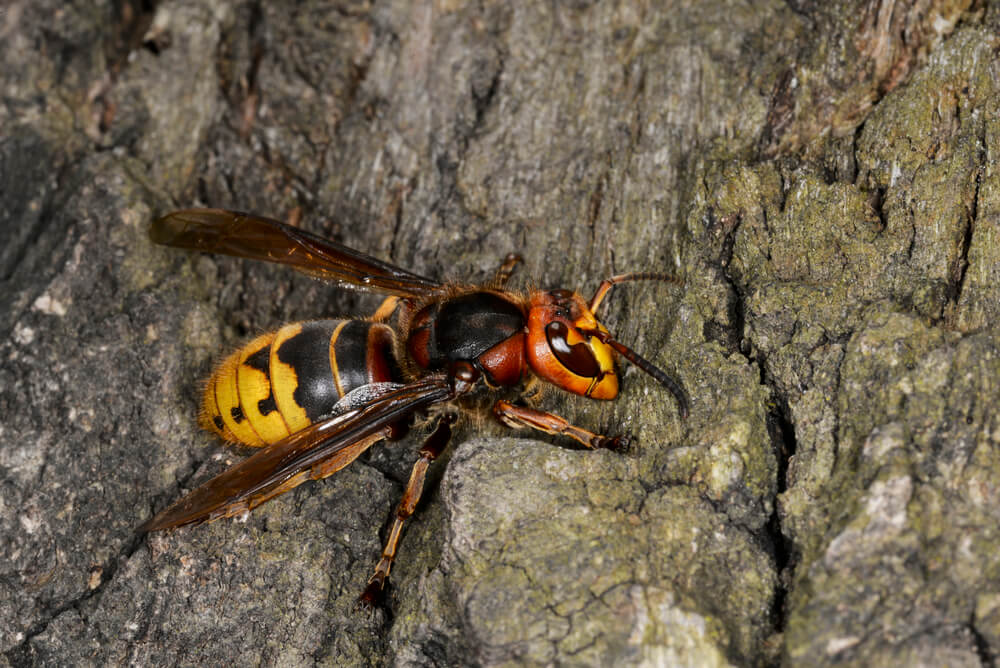In this article:
Let’s face it.
It’s frustrating to see dozens of carpenter bee holes in your deck, porch, or home. You want to get rid of the carpenter bees ASAP.
But this is where most people run into trouble.
They either spray the carpenter bees with wasp spray or hang carpenter bee traps.
The only problem?
Neither of those methods prevent other carpenter bees from coming around. Sure, it kills a few carpenter bees on the spot, but more carpenter bees are going to eventually come around to replace them.
Secondly, there are natural ways to deter carpenter bees without killing them.
Why is this important?
Because carpenter bees are crucial pollinators of many flowering plants found in the United States. In fact, pollinators like carpenter bees are responsible for 1 in 3 bites of food we eat.(1)
To take it a step further?
Bees are also considered a keystone species.
In an ecosystem, a keystone species helps hold the entire system together. Without them, the ecosystem would be significantly different or cease to exist altogether.
So now you might be asking:
Well, how do you deter and prevent carpenter bees naturally?
It’s easier than you might think.
Related: Do Carpenter Bees Pollinate?
How to Get Rid of Carpenter Bees Without Harming Them
This technique is a two-fold approach to getting rid of carpenter bees. Don’t skip on either step if you want to stop the carpenter bees for good.
Step 1: Start by Spraying This on Your Wood

Two things naturally repel carpenter bees:
Citrus oil and almond oil. You can use either one.
For the citrus oil method, start by pouring citrus oil into a spray bottle. You can combine it with water, but don’t overdilute it since you want the citrus oil to have a strong odor.
Next, spray the citrus oil generously around the holes where the carpenter bees are nesting.
Note:
Don’t spray inside their holes because you don’t want to harm them – only repel them. Just spray along exposed wood.
You can also create your own citrus spray by boiling citrus peels in water for several hours. Make sure you boil enough peels in the water to ensure the citrus scent is very potent.
The almond oil method works similarly to the citrus oil method, except I prefer “painting” the almond oil on the wood instead of spraying it.
But, you may need to test a small patch first because almond oil can stain some types of wood.
Now keep in mind:
Don’t assume that any type of oil will work to deter carpenter bees. Stick to almond oil or citrus oil only.
For example, using vegetable oil, canola oil, or olive oil from your kitchen will be pointless. Those oils don’t repel carpenter bees like citrus or almond oil does.
Related: Do Carpenter Bees Sting?
Step 2: Place a Bee Hotel Nearby
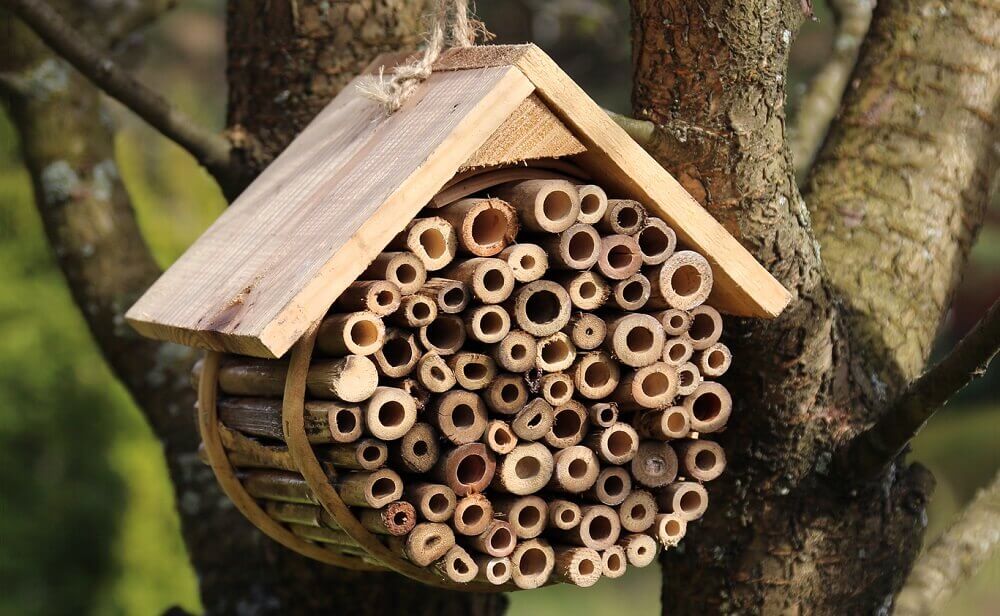
Confession time:
A few years ago, I moved into a log cabin made from aged cypress wood.
Little did I know?
Cypress is one of carpenter bee’s favorite types of wood.
Springtime hit, and I suddenly had dozens of carpenter bees burrowing into my cabin. I could hear them buzzing constantly.
So what did I do?
From the recommendation of a friend, I bought this bee hotel and put it on the other side of the yard, where the plants are, and the humans aren’t.
But remember:
This is a two-fold method. I started by spraying my porch with citrus oil first, then hung two bee hotels to attract the carpenter bees to them.
Soon after, the carpenter bees moved out of my cabin and into the bee hotel, and we all lived happily ever after.
Related: Do Bumble Bees Sting?
The 3 Things to do for Carpenter Bee Prevention
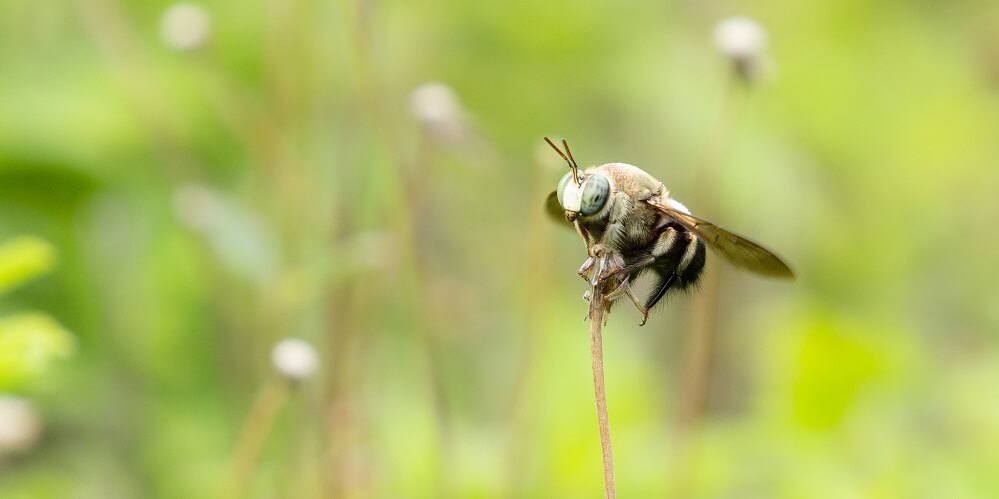
Spraying citrus/almond oil and buying a bee hotel works well in the spring. But when fall hits, you can take a few extra steps in preventing carpenter bees.
Remember:
Do these things in the fall or winter. I’ll explain why in a second.
Here’s what you do:
- Step 1: Find any previous carpenter bee holes. These are usually found in porches, decks, window sills, and fences.
- Step 2: Seal any holes. It’s always a smart idea to fill carpenter bee holes with something durable, such as plugs, caulk, or putty.
- Step 3: Add a finish to your wood. Unfinished wood is attractive to bees. So, to prevent carpenter bees from damaging your property, the best and most efficient way is to paint or add a finish to the wood.
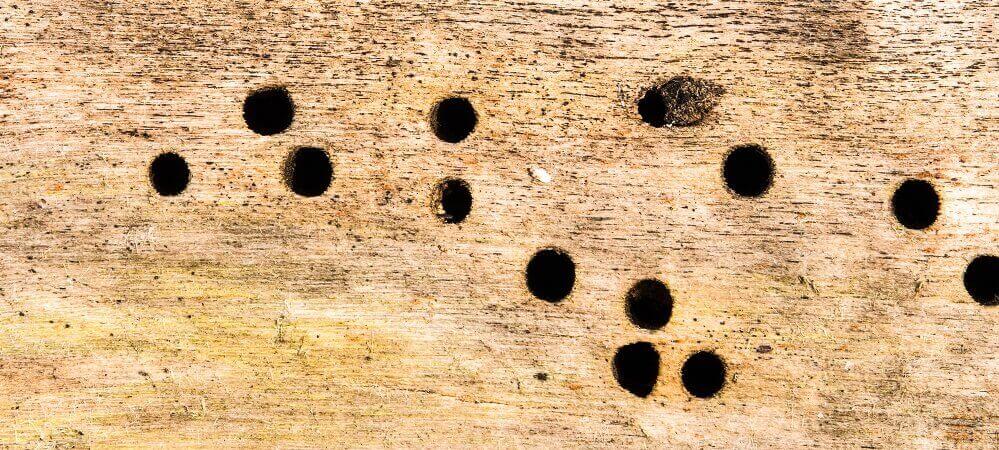
Now you might be asking:
Why should I do these things in the fall or winter?
Simple.
Once you’ve used citrus or almond oil and added a bee hotel to your yard, the carpenter bees will leave.
After that, you’ll need to plug up any empty holes during the fall and winter when the bees aren’t active.
If you seal up holes while the carpenter bees are inside, they’ll tunnel their way out and continue to damage your property.
Also, since carpenter bees are essential pollinators, you don’t want to harm them – only deter them. Carpenter bees won’t be nesting in the fall or winter, so you can find and fill holes without problems.
Related: Do Bumble Bees Make Honey?
Related: How Long Do Bumble Bees Live?
FAQs about How to Get Rid of Carpenter Bees
- How long do carpenter bees stay around?
- How damaging are carpenter bees?
- How do you find a carpenter bee nest?
- What attracts carpenter bees to my house?
- What will keep carpenter bees away?
- What kills carpenter bees instantly?
- What smell do carpenter bees hate?
- Will mothballs deter carpenter bees?
- Will wasp spray keep carpenter bees away?
- Do carpenter bee traps work? Where do you hang a carpenter bee trap?
How long do carpenter bees stay around?
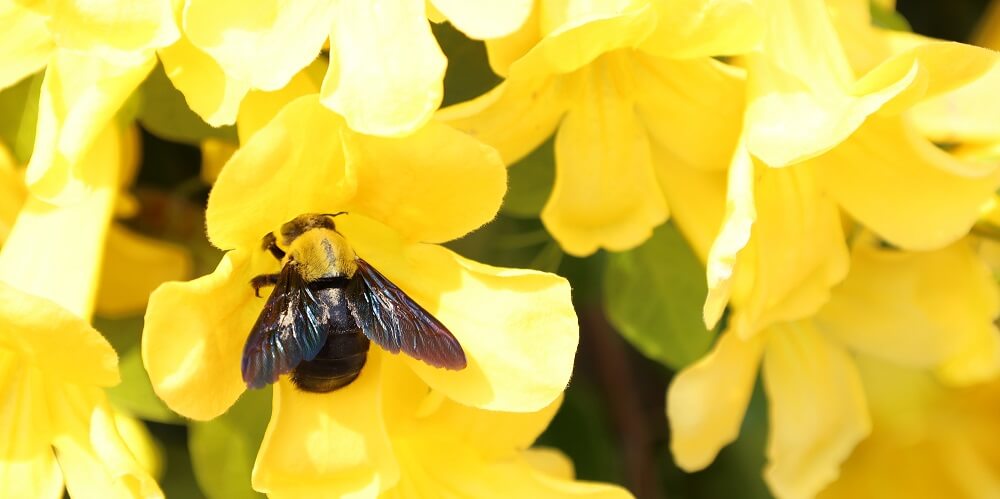
Carpenter bees are active from early spring to late summer.
Then, they’ll hibernate throughout the winter until the following spring.
Carpenter bees hibernate in pre-existing nests, which is why it’s important first to deter them. Citrus oil and a bee hotel will do the trick.
Once it’s warm enough the following spring, they’ll come out of their nests in search of fresh pollen and nectar. Then mating season begins.
Following mating, males will begin to die, and females will fill pre-existing nests with fresh eggs and dig new nests.
Female carpenter bees can live for at least two years, and it’s possible that she’ll be able to lay her eggs through most of the summer. However, she won’t usually survive two winters.
—> Go back to the “How to Get Rid of Carpenter Bees” FAQs
More to Explore:
How damaging are carpenter bees?
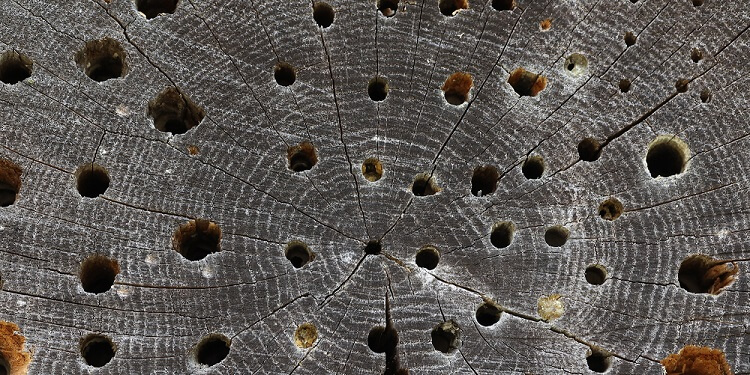
While carpenter bees are fairly harmless to humans since they’re gentle bees, they can cause cosmetic damage to your home.
Carpenter bees rarely cause serious damage to wood unless dozens of them are drilling numerous tunnels over many years. As mentioned, it’s mostly cosmetic damage more than anything.
—> Go back to the “How to Get Rid of Carpenter Bees” FAQs
More to Explore:
How do you find a carpenter bee nest?
First, you need to know what they look like.
Carpenter bees create nests inside exposed wood. They drill holes about 1/2 inch in diameter in window sills, porches, decks, fences, overhangs, and other wooden areas.
Sometimes you’ll even see a sawdust‐like substance underneath the holes that happens when the carpenter bee drills. You also might see a brownish substance by the hole (carpenter bee feces) or yellow dust (pollen).
—> Go back to the “How to Get Rid of Carpenter Bees” FAQs
More to Explore:
What attracts carpenter bees to my house?
One word:
Wood.
In particular, unfinished or weathered wood attracts carpenter bees the most. And although carpenter bees prefer softwoods such as cypress, redwood, or cedar, they’ll also resort to pine or other wood if necessary.
But here’s a common misconception:
Carpenter bees don’t eat wood. They eat pollen and nectar like other bees do.
Instead, they just drill into wood to build their nests.
And actually, the female carpenter bee does the drilling. She has strong jaws (called mandibles) that she moves in a circular manner. This allows her to drill holes an inch deep in just a few short days.
Here’s a video showing carpenter bee holes:
—> Go back to the “How to Get Rid of Carpenter Bees” FAQs
More to Explore:
What will keep carpenter bees away?
This is one of the most asked questions we get. It sometimes comes in a slight variation, for example:
How do I keep carpenter bees out of my log home?
How do I keep bees away from my wood deck?
How do I get rid of carpenter bees in my porch?
Regardless, the goal is still the same:
Deter and prevent carpenter bees without hurting them.
As mentioned above, the two best ways to deter carpenter bees naturally is to use citrus oil or almond oil on exposed wood. Spray or “paint” the wood with either one of those oils.
Next, buy a bee hotel so the carpenter bees will have a new home. Using both of these techniques will deter the carpenter bees without harming them.
Don’t forget:
Once the carpenter bees leave their old holes in your home, it’s best to find and fill the holes with putty, caulk, or plugs. This will prevent them from coming back next season.
To take it a step further, stain or paint untreated wood. Carpenter bees prefer natural, untreated wood.
—> Go back to the “How to Get Rid of Carpenter Bees” FAQs
More to Explore:
What kills carpenter bees instantly?
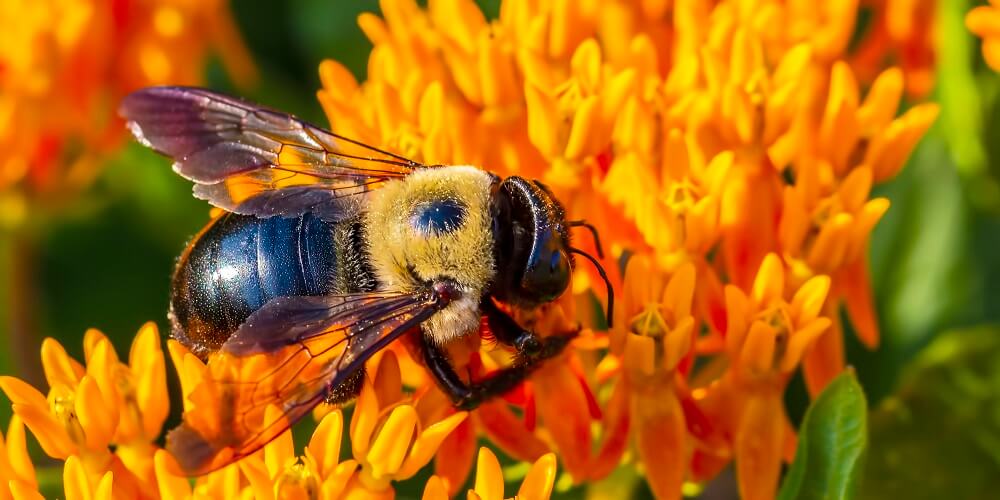
Let me guess.
You’re frustrated that carpenter bees are drilling into your wood, and you want them gone ASAP.
I get it.
Nobody wants to see dozens of little bee holes ruining their porch, deck, or home.
But here’s the thing:
There’s a better way to remove carpenter bees than to kill them. It’s a two-step method that’s cheap and deters carpenter bees naturally.
Here’s what you do:
Step 1: Spray Your Wood with Citrus or Almond Oil

Carpenter bees hate the smell of citrus and almond oil.
Better yet?
It repels them without harming them.
To use the citrus oil method, start by filling a spray bottle with citrus oil. You may also add water, but don’t overdo it since you want the citrus oil to remain pungent.
Next, spray the citrus oil liberally around the carpenter bee holes and any exposed wood.
You may also make your own citrus spray by boiling citrus peel in water for several hours, then transferring the mixture to a squirt bottle. Make sure you use enough citrus peels to ensure that the citrus fragrance is strong.
The almond oil method is comparable to the citrus oil method, but I prefer “painting” the almond oil on the wood rather than spraying it.
However, you may need to test a tiny area first because almond oil may stain some woods.
Now don’t forget:
Don’t assume that any sort of oil will keep carpenter bees at bay. Stick to almond oil or citrus oil only.
For example, using vegetable oil, canola oil, or olive oil from your kitchen will provide no benefit. Unlike citrus or almond oils, these oils don’t repel carpenter bees.
Step 2: Add a Bee Hotel to Your Yard
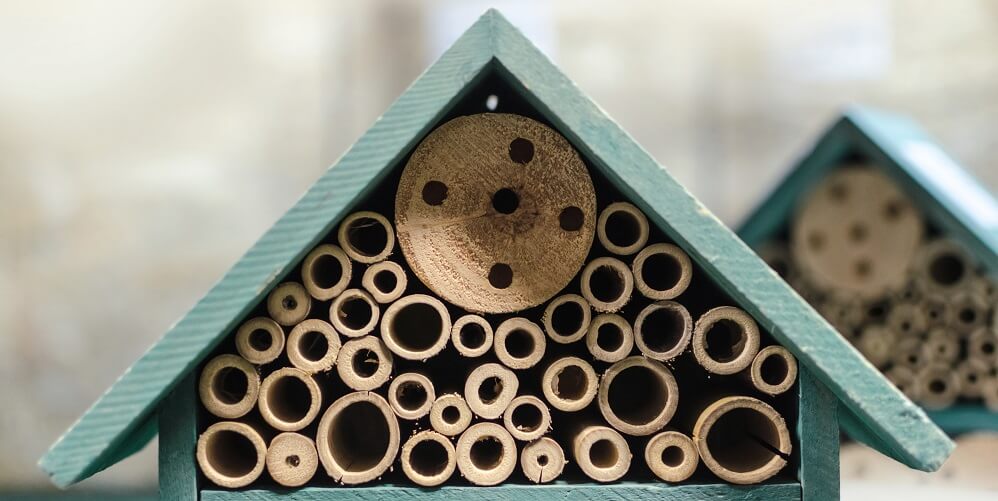
I have a quick story.
I recently moved into a lovely log cabin made of aged cypress trees.
The only problem?
Carpenter bees love cypress. It’s one of their favorite types of wood.
So my friend recommended I buy a bee hotel to help remove the carpenter bees. I bought two bee hotels and stuck them in the yard immediately.
Next thing you know?
The carpenter bees moved out of my porch and into their new bee hotel.
I was happy. The carpenter bees were happy. And we all lived happily ever after.
Win-win.
But let me be clear:
I made sure not to skip step one above. I applied citrus oil to my porch first, then installed two bee hotels so that the carpenter bees would leave my cabin alone.
This is why when someone wonders some variation of:
- How to get rid of carpenter bees with wd40
- How to get rid of carpenter bees with vinegar
- How to get rid of carpenter bees with a paper bag
- What kills carpenter bees on contact?
I always tell them the easiest and most effective way to remove carpenter bees is through citrus/almond oil and a bee hotel.
—> Go back to the “How to Get Rid of Carpenter Bees” FAQs
More to Explore:
- Honeybees vs. Bumblebees: How Do They Compare?
- Are Worker Bees Male or Female?
- What Do Bumble Bees Eat?
What smell do carpenter bees hate?
Carpenter bees dislike the scent of citrus oil, just like many other insects. This makes citrus oil an excellent natural repellant against carpenter bees.
Carpenter bees also dislike the smell of almond oil, peppermint oil, and tea tree oil.
—> Go back to the “How to Get Rid of Carpenter Bees” FAQs
More to Explore:
Will mothballs deter carpenter bees?
Some people claim that placing mothballs around your home will keep carpenter bees away. While I’ve never tried this approach, it may work as a natural repellent for carpenter bees.
But one caveat:
I don’t recommend putting mothballs in your garden. It could deter pollinators like bees, butterflies, hummingbirds, and others from tending to your garden.
—> Go back to the “How to Get Rid of Carpenter Bees” FAQs
More to Explore:
- How Long Do Bees Live?
- Wasps vs. Honeybees: How Do They Compare?
- Why Do Vulture Bees Eat Rotting Flesh?
Will wasp spray keep carpenter bees away?
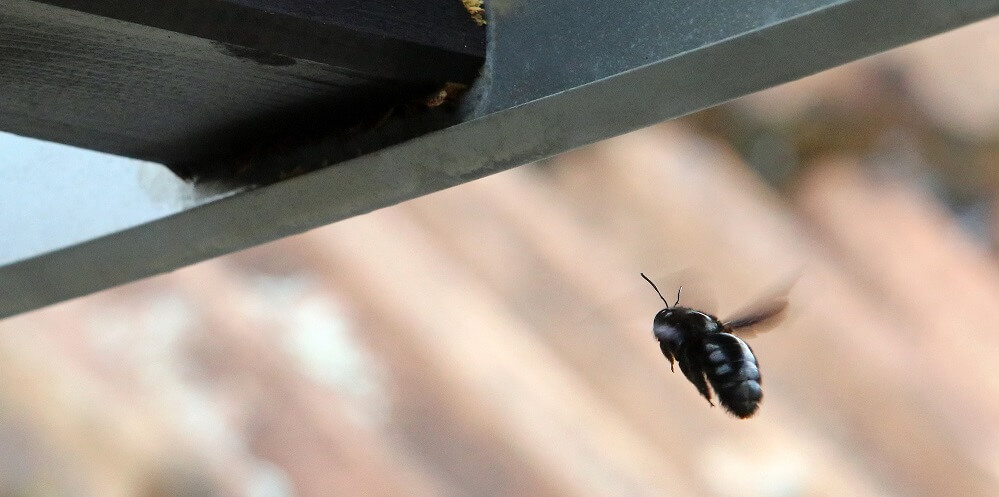
No, wasp or hornet spray will only kill the present carpenter bees – it won’t deter future carpenter bees from coming.
The smartest way to keep carpenter bees away is to spray citrus oil around areas of exposed wood. Using citrus oil is a natural carpenter bee deterrent because they dislike the smell.
Next, you’ll want to place a bee hotel in your yard to divert the bees’ attention.
If you spray citrus oil around exposed wood and set up a bee hotel, you’ll prevent carpenter bees from coming back in future seasons.
—> Go back to the “How to Get Rid of Carpenter Bees” FAQs
More to Explore:
Do carpenter bee traps work? Where do you hang a carpenter bee trap?
Carpenter bee traps work, but you should think twice before using them. Opt for natural carpenter bee repellants instead.
Remember:
Carpenter bees are crucial pollinators. In fact, 15% of US crops are pollinated by carpenter bees and other native bees.(2)
So how do you remove carpenter bees without hurting them?
Simple.
Carpenter bees hate the smell of citrus oil and almond oil. You can spray either of these oils around areas of exposed wood. Be sure to spray liberally too.
Also, divert the carpenter bee’s attention by placing a bee hotel in your yard. This will shift their focus from your house into their new bee hotel.

